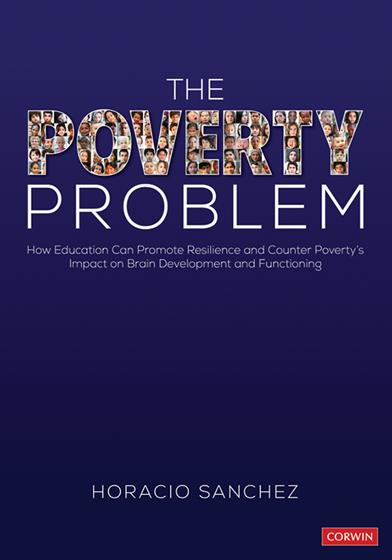
Hands-on, Practical Guidance for Educators
From math,
literacy, equity, multilingual learners, and SEL, to assessment, school counseling,
and education leadership, our books are research-based and authored by experts
on topics most relevant to what educators are facing today.

The Poverty Problem
In The Poverty Problem, you’ll learn how to increase students’ perseverance and confidence and positively impact outcomes by arming yourself with research-based instructional strategies that are inspiring, realistic, and proven to work.

- Grade Level: PreK-12
- ISBN: 9781071842928
- Published By: Corwin
- Year: 2021
- Page Count: 280
- Publication date: January 27, 2021
Price: $39.95
For Instructors
When you select 'request review copy', you will be redirected to Sage Publishing (our parent site) to process your request.
Description
Economic hardship is changing our students’ brain structures at a genetic level, producing psychological, behavioral, and cognitive issues that dramatically impact learning, behavior, physical health, and emotional stability. But there is hope.
This groundbreaking book by one of the nation’s top experts in brain science and resilience offers solutions that will change minds, attitudes, and behaviors. Learn about how problems develop between people of different races, how the brain develops in persistent poverty, and how it might react to solutions. Inside, you will find real-life applications on topics including:
• The lack of culturally competent instruction and its impact on students of color
• Poverty's effect on language development and how it can be positively influenced
• The importance of reading
• How to counteract the effects of the widespread stress in lower SES environments
Children make up 23% of the U.S. population and account for almost 33% of those living in poverty, making the education system our most distressed institution. In The Poverty Problem, you’ll learn how to increase students’ perseverance and confidence and positively impact outcomes by arming yourself with research-based instructional strategies that are inspiring, realistic, and proven to work.
Author(s)

Horacio Sanchez
Table of Contents
Preface
Summary
About the Author
Introduction: The Invisible Line
Chapter 1: The New Deal—The Old Way
Chapter 2: More Than a Lapse in Judgment
Chapter 3: Born Behind the Eight Ball
Chapter 4: Speechless
Chapter 5: You’ve Lost That Loving Feeling
Chapter 6: See No Evil, Hear No Evil, and Speak No Evil
Chapter 7: Poverty Is a Story of Risk
Chapter 8: Principles of Good Instruction for Students from Low SES
Chapter 9: The Only Academic Protective Factor
Chapter 10: Promoting Resiliency
Appendix A
Model Lesson: Goal Setting
Appendix B
Model Lesson: Promoting Hope and Expectation
Appendix C
Model Lesson: Having a Good Sense of Humor
References
Index
Reviews
"In The Poverty Problem, Horacio Sanchez sounds an alarm and sends out a call to action. He asks educators to roll up their sleeves and move beyond merely understanding the problem of poverty to taking the lead in creating, implementing, and applying strategies to counter the negative impact poverty has on students’ education.
The author helps educators understand that the brain is changing and adjusting due to poverty. This change has a direct negative impact on student learning and behavior. Adverse consequences include issues with language development, resiliency, and stress-related actions. He illustrates how implicit bias associated with poverty and people of color unfairly knits the two together and exacerbates the challenges these students face. Poverty is a major factor impeding the academic progress of students experiencing it. As the author provides a look back into the history of how America came to “measure” poverty, he shows that it is a force continuing to negatively influence the overall academic achievement landscape in this country. Educators would be wise to keep this book at their fingertips."
Paula Y. Daniels, Director, Office of Educational Supports"In The Poverty Problem, Horacio Sanchez sounds an alarm and sends out a call to action. He asks educators to roll up their sleeves and move beyond merely understanding the problem of poverty to taking the lead in creating, implementing, and applying strategies to counter the negative impact poverty has on students’ education.
The author helps educators understand that the brain is changing and adjusting due to poverty. This change has a direct negative impact on student learning and behavior. Adverse consequences include issues with language development, resiliency, and stress-related actions. He illustrates how implicit bias associated with poverty and people of color unfairly knits the two together and exacerbates the challenges these students face. Poverty is a major factor impeding the academic progress of students experiencing it. As the author provides a look back into the history of how America came to “measure” poverty, he shows that it is a force continuing to negatively influence the overall academic achievement landscape in this country. Educators would be wise to keep this book at their fingertips."
Michigan Department of Education, Lansing
"This book is long overdue. Educators at every level will benefit by understanding children, human development, and the influence of poverty and race. Moreover, this book includes well-informed strategies to help students focus and learn to read. I am hopeful that preservice education and Departments of Education around the country will ensure that educational programs include the information and strategies presented in The Poverty Problem."
Gerald Zahorchak, D.Ed, Former Pennsylvania Secretary of Education, Education Division Chair"This book is long overdue. Educators at every level will benefit by understanding children, human development, and the influence of poverty and race. Moreover, this book includes well-informed strategies to help students focus and learn to read. I am hopeful that preservice education and Departments of Education around the country will ensure that educational programs include the information and strategies presented in The Poverty Problem."
University of Pittsburgh at Johnstown
"As an educator for over 30 years, I have sought out information from experts on various topics, seeking to improve my practice and be a support to others. The Poverty Problem is the most helpful professional book I have read. Understanding the neurological changes that occur in the brain at very early ages is key to implementing effective interventions at school. Without this background, we are doing good things with good intentions, but our efforts are not having a long-term impact because we are not addressing the real issues. With so many responsibilities and not enough time to address all the demands placed on the school system, we need to make sure our efforts are focused on the most effective and efficient strategies. This book offers exactly that. In addressing the impact of poverty, we can now work smarter to ensure that each child has every opportunity possible to succeed in school. We now have tools to help reverse the negative impact poverty has on our students’ educational experiences."Cathy Nichols-Washer, Ed. D., Superintendent
Lodi Unified School District
“The Poverty Problem is the book I wish I had when I was teaching! Combining brain science with education, the author explains potentially baffling behaviors seen in students coming from poverty. In light of the well-entrenched systems that effectively keep people from breaking free of the cycle of poverty, it is tempting to consider these problems as unfixable. However, this is a book of hope: Each chapter ends with concrete actions and attitudes that can be adopted to combat poverty’s assault on the human brain, increasing resiliency and ultimately the potential for success in all students.”Julie Porter, Education Consultant
Promethean
"Horacio Sanchez's ability to turn research and best practice into applicable, turn-around action steps hits the mark once again! His work provides incredible benefit to the field of education by providing foundational understanding, building contextual frameworks, and fostering resiliency. This book clearly connects the multi-faceted layers of poverty, racial dynamics, trauma, and generational patterns. In sharing his insights to positively alter the field of education, the author gives us a gift."
Regina C. Speaker, Ed.D., Executive Director"Horacio Sanchez's ability to turn research and best practice into applicable, turn-around action steps hits the mark once again! His work provides incredible benefit to the field of education by providing foundational understanding, building contextual frameworks, and fostering resiliency. This book clearly connects the multi-faceted layers of poverty, racial dynamics, trauma, and generational patterns. In sharing his insights to positively alter the field of education, the author gives us a gift."
Montgomery County Intermediate Unit, Norristown, PA
“Like many who have read your books, I am celebrating your commitment to redirecting toxic conversations about poverty into dialogues that promote a deeper understanding of the needs of ALL children, free from judgment and opening our hearts and minds to new understanding.”Sandra Welander McCartney
The Center for the Collaborative Classroom
For Instructors
When you select 'request review copy', you will be redirected to Sage Publishing (our parent site) to process your request.
Related Resources
- Supporting Students in Poverty [Podcast]
- The Invisible Line [Book excerpt]
